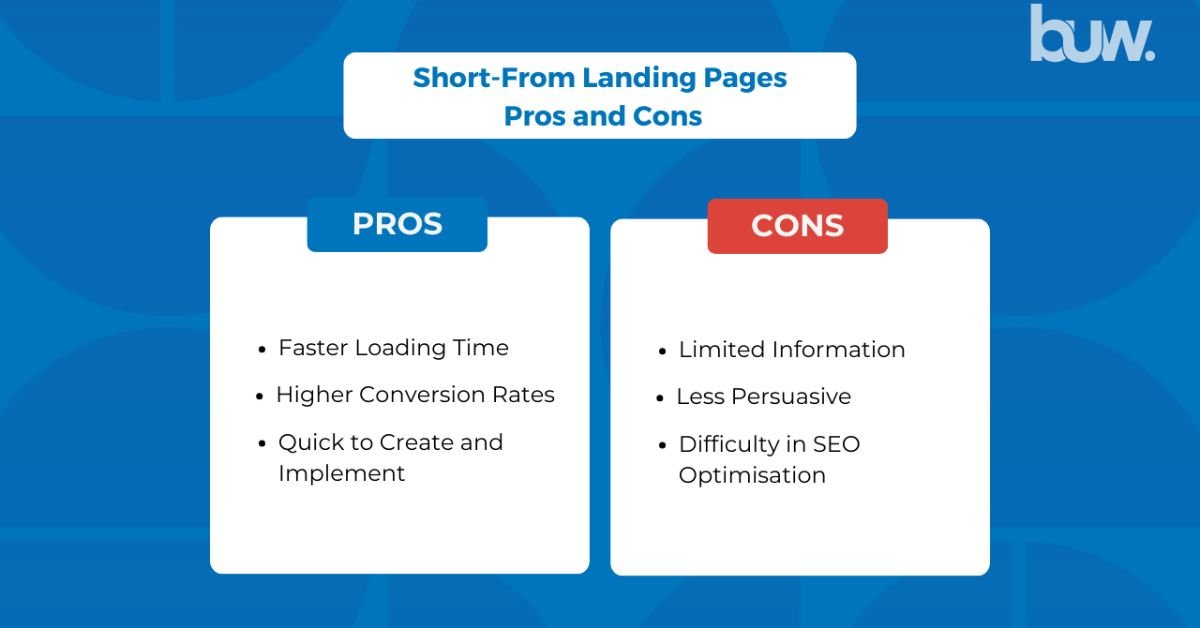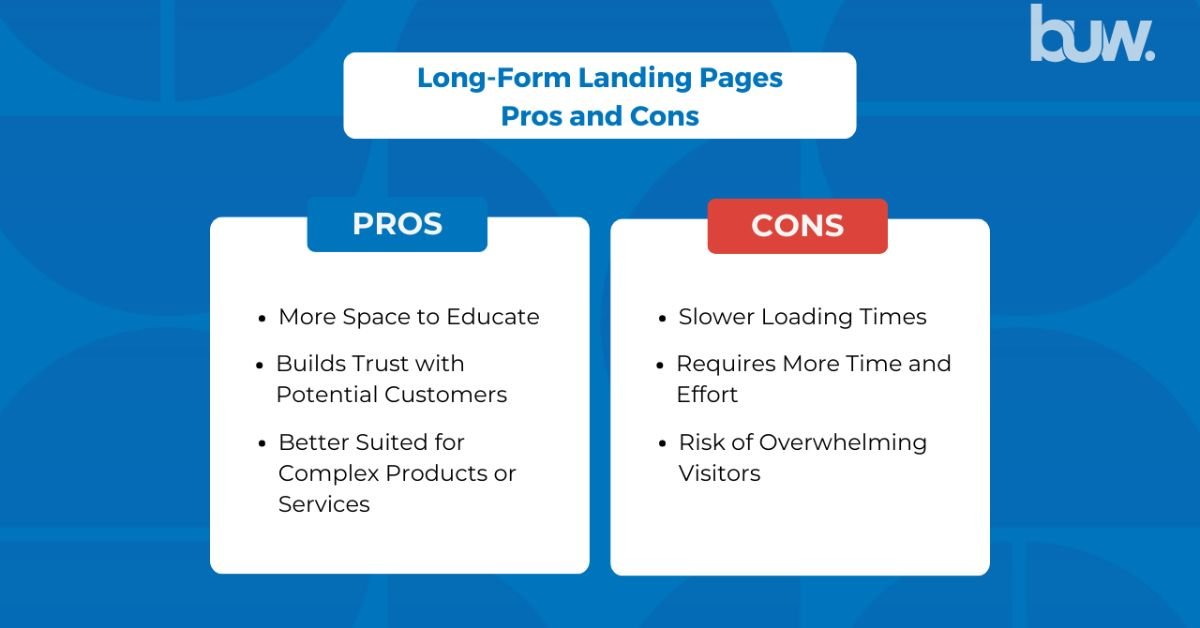Have you ever visited a website that was loaded with text or that left you more confused than resolved?
These were probably landing pages competing for your time and attention. Landing pages are the digital backbone of marketing campaigns, capturing leads and converting website visitors into paying customers or subscribers.
But not all landing pages are identical, just like your target demographic. Executives such as yourself value time and clarity in the fast-paced world of today.
So the question is, when it comes to landing pages, do you go for the short and simple choice or the in-depth and informative option?
Landing pages are your best bet for generating leads, closing deals, or just spreading awareness. Did you know that companies with 10 to 15 landing pages increase leads by 55%? You heard correctly! Landing pages are the real MVPs in the digital marketing game.
This blog aims to equip you with the information you need to make well-informed choices about your landing page strategy.
Before we go further, let’s establish a common ground.
What is a Landing Page?
A landing page is a standalone web page built to capture leads or conversions. It’s where you focus your marketing efforts, including search engine optimisation (SEO), social media ads, and email marketing.
Short-From Landing Pages
These are short and clear, frequently with excellent graphics, a call to action (CTA), and little to no text. They’re perfect for gathering leads for straightforward promotions like downloads, free trials, or email signups. Users are better engaged and focused on the urgent action you want them to take when using short forms.

Pros
Faster Loading Time
Imagine this: a customer is excited to check out your offer while browsing on a mobile device. Hold on, what’s this? With each second that went by, a slow loading bar stretched across the screen, trying their patience.
This situation is something you can forget about with short-form landing pages. Your page loads quickly because it has cut out the unnecessary elements and concentrated on the important stuff. Perfect for people who need immediate satisfaction while on the go or for those with limited data connections.
Higher Conversion Rates
Every effective landing page has a call-to-action (CTA) that is strong enough to encourage visitors to take the next action. But creating a compelling call to action is just half the battle. Both the presentation and the surrounding context are important factors in influencing conversions.
This is where short-form landing pages shine because they convey clarity and a sense of urgency.
Quick to Create and Implement
Time is at the core of the fast-paced world of digital marketing. With the expedited creation process provided by short-form landing pages, you can launch your campaigns quickly. You can test several iterations and optimise for maximum impact, iterate quickly, and work with fewer elements to create and improve.
Cons
Limited Information
A short-form landing page is great at drawing visitors in, but it might not be as good at explaining complex details. Products or services that need a lot of explanation could not work well on a short-form landing page, which would make potential buyers want to know more.
Less Persuasive
Successful marketing campaigns must address potential objections and build your brand authority and credibility. Unfortunately, because they are so short, short-form landing pages could find it difficult to accomplish this.
Convincing apprehensive buyers becomes a difficult task when there isn’t enough room to go into detailed arguments or offer extensive testimonies.
Difficulty in SEO Optimisation
Relevance and depth of content are critical components of search engine optimisation (SEO). Search engine algorithms may not find sufficient information on short-form landing pages, which could affect how visible your website is in search results.
Your page may have trouble ranking highly if it doesn’t have enough text and keywords, which would reduce its organic reach and traffic.
Long-Form Landing Pages
Long-form landing pages are more thorough; they answer any potential concerns, provide thorough details about your product or service, and foster credibility with prospective clients.
They frequently include components like case studies, testimonies, and insights derived from data. Long forms are more time-consuming for the user but can be very useful for technical items or services that need detailed explanations.

Pros
More Space to Educate
Longer landing pages, as opposed to short ones, offer more room for you to go into detail about your value proposition. You have the opportunity to elaborate on the benefits of your offering, draw attention to its special qualities, and demonstrate how it addresses the needs of your target market.
With the help of this expanded canvas, you can create an engaging story that will effectively and persuasively lead your audience through the buyer’s journey.
Builds Trust with Potential Customers
Any effective business connection is built on trust. In this sense, long-form landing pages excel since they offer data-driven and social proof to back up your claims. Case studies, statistics, and testimonials provide trust and credibility, dispelling their fears and boosting your brand’s reputation.
You can establish lasting relationships with prospective clients by creating a trustworthy narrative that will reward their loyalty and ongoing engagement.
Better Suited for Complex Products or Services
Some offerings require more than just a glance to understand their value fully. Complex products and services frequently have abundant features, advantages, and applications that call for in-depth justification.
In this case, long-form landing pages excel because they provide an extensive database of data that covers every angle. Long-form landing pages let you cover every aspect of your product, from user reviews to technical specs, whether you’re selling software, financial services, or luxury items.
Cons
Slower Loading Times
Long-form landing pages may not load as quickly as their short-form alternatives, particularly on mobile devices. Long loading times might cause visitors to become frustrated and impatient at a time when they expect instant access to information.
Since people are leaving the website before it loads completely, this may lead to higher bounce rates. Optimising for fast load times is essential for maintaining user engagement and preventing lost leads as mobile surfing becomes more common.
However, it is not always the case. You can purposefully design landing pages that are light-weight and employ lightning-fast servers to ensure that pages load quickly.
By prioritising efficient design and leveraging high-performance servers, long-form content can be delivered quickly to users, resulting in a seamless browsing experience that encourages engagement and reduces bounce rates.
Requires More Time and Effort
It takes skill to create an engaging, long-form landing page. It requires in-depth preparation, a great deal of research, and expert copywriting abilities. Long-form content necessitates greater complexity and detail than short-form landing pages, which place a higher value on conciseness.
This means dedicating more time and resources to the design, optimisation, and production of content.
Risk of Overwhelming Visitors
Long-form landing pages can be informative and persuasive, but if they are not engaging and well-structured, they run the danger of overwhelming visitors. This can result from too much knowledge provided in an unorganised way, which can confuse and turn off visitors.
Users could find it difficult to explore the information or understand the main points among a sea of text, photos, and multimedia elements.
Which One is Better?
In business, results often depend on various factors. From our experiment, we’ve found that long landing pages tend to convert better than shorter ones, though both have their merits. Long-form content, in particular, has proven to be highly persuasive in driving conversions.
Frequently Asked Questions (FAQs)
Let’s go over some frequently asked questions from executives about short-form and long-form landing pages.
Yes, combining long- and short-form landing pages targets diverse demographics. A/B testing of both ensures the perfect conversion strategy.
The frequency of updating your landing pages depends on different variables, such as adjustments to your offering, shifts in market trends, and the effectiveness of your current pages. You can use HotJar to monitor regularly and conducting evaluations to find opportunities for optimisation or improvement is a useful practice.
Case studies and testimonials are powerful trust signals that have a big impact on how visitors perceive a place and make decisions. Whether it’s through case studies that highlight successful outcomes, endorsements from industry experts, or testimonies from happy customers, you can help your visitors feel more confident and less doubtful.
Conclusion
We hope that this blog has helped to clarify the discussion about the difference between short and long-form landing pages.
Remember that the most effective plan of action depends on your particular set of circumstances; there is no right or incorrect answer.
So, pause to consider which strategy best fits your target demographic and advertising goals. Take a chance, experiment with different things, and see how much more you convert!
Are you ready to improve your landing page strategy and drive better results for your campaigns, book an appointment now to unlock the full potential of your digital marketing efforts!
Latha Karthigaa, founder of Brandupwise (BUW) Marketing, is dedicated to improving lead generation for medium to large enterprises. Her strategic insights focus on lead generation, client acquisition, and most important of all educating the businesses and their internal teams about sustainable growth. As a transformative force in the industry, she reshapes the narrative of success for every business under her expert guidance.
Contact
- latha(at)brandupwise(dot)com(dot)au







